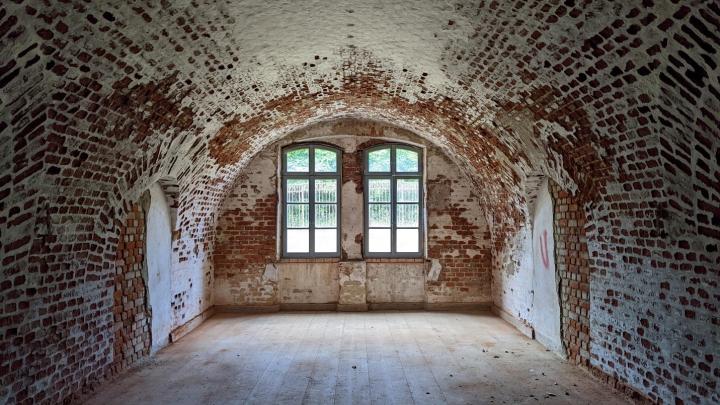Modernism, borders, and Joseph Conrad's "Amy Foster"
Posted
Time to read
Juliette Bretan is a PhD candidate in English at the University of Cambridge. Her PhD explores representations of Polish and East-Central European geopolitics in Anglophone and Polish modernism, and she also researches connections between Lincolnshire and modernism. She has recent work in Critical Quarterly and The Cambridge Quarterly, and has previously written for The Public Domain Review, The Modernist Review, Engelsberg Ideas, and The Arts Desk, among others.
For a literary movement often characterised by cosmopolitanism, internationalism, plurilingualism and emigration (see Malcolm Bradbury and James McFarlane) – as well as a rupture with tradition – there are a good many borders and border-crossings in modernist works, from fragmented and blurred genres to travel narratives, and from the influence of multi-national artists and rambling flaneurs, to the particular proliferation of politicised perimeters within the work of left-wing 1930s writers (including WH Auden and Christopher Isherwood’s On the Frontier (1938) and Edward Upward’s Journey to the Border (1938) – as discussed by Rod Mengham).
![Emigrants, une arrivée [le pont d'un navire arrivant à Ellis Island remplis d'émigrants] : [photographie de presse] / [Agence Rol]](/sites/default/files/inline-images/Screenshot%202024-02-19%20094913.jpg)
As Paul Fussell and James Purdon have noted, the early twentieth-century – with its openness to travel, informatic technology, and expanding economies – saw new processes and systems imposed on European borders. This included the 1905 Aliens Act, the first British law of immigration control; the introduction of passports; and the (re)imposition of national boundaries. In part, such measures, as modernist works attest, were an element of efforts to shore up national identity, tradition, and meaning against real and imagined threats, through recourse to locality (see work by Jed Esty), or geographical extension and claim; in part incited dreams of lavish international diversity, and possibilities for renewal; or edged into absurd fastidiousness, violence, and blurred, yet charged, questions of the boundaries between self and other. Anxieties at the time about borders were particularly prevalent on Europe’s east. This region – which might be broadly conceived as anything east of Germany – was one from which hundreds of thousands of individuals, had left for Britain and the west (with concerns over high levels of migration a partial reason for the introduction of the Aliens Act), and incited particularly heady stereotypes about otherness, backwardness, unfamiliarity and possibilities for disruption (see Larry Wolff).
Joseph Conrad’s ‘Amy Foster’ (1901) is one work which concerns modern border controls, their impact on individuals, and East-Central Europe. The story describes one ‘emigrant from Central Europe’ – who is given the haphazardly-rendered East-Central European name, Yanko Goorall, by the British characters he encounters, after he is shipwrecked in Britain en route to America. He ultimately dies, after he fails to make himself understood to the British characters. With its themes of East-Central European migration and troubled integration, it is most often considered as analogy for Conrad’s own difficulties as a Polish emigrant to Britain; with complexities lost to a subsuming framework of authorial mirroring (see Josephine McDonagh and Richard Ruppel). But these connections are fragile and, in many cases, reductive (see Norman Davies, and for Conrad’s experience see Zdzisław Najder). I want to suggest that, through modernist thematic and formal techniques, ‘Amy Foster’, might thus be read beyond a story of difficult assimilation into a new country, for it also alludes to mass migration controls which play out at the modern border.
I want to focus here on Yanko’s cross-border journey, in the first half of ‘Amy Foster’. The story begins with the shipwreck which leaves the character in Britain, then gradationally defers back to his experience on the ship, back to his train travel through Europe, back to his departure from his hometown, and back to his aspirations for emigration, before returning to his initial disorientating emergence onto the British coast. The journey to the west, itself bordered by two descriptions of the shipwreck, therefore forms a neatly historicised, separate experience of structured cross-border transit, which is ultimately disrupted physically, narratively, and teleologically as the ship sinks.
This section is layered up through a series of temporal and spatial markers (‘before that’; ‘once he was made’; ‘then…’) to forge episodic stages. The slow, backdated revelation of these stages of the journey is a common Conradian technique, which Ramon Fernandez refers to as ‘delayed decoding’, through which Conrad’s impressionistic style slowly crystallises into concepts (see Ian Watt). David Glover has suggested this ‘stark and claustrophobic’ style both brings readers closer to, and distances them from, Yanko’s experience; and ‘the distancing effect is social and cultural too, for the device of the shipwreck effectively removes the migrant from the metropolitan crucible in which “the Alien Question” is posed’. But, as a separate section from the British narrative, the delayed decoding not only marks out the hazy and potentially illusory consolidations of cognitive processes, but is also a temporal, locative, and affective brace. I want to suggest here that Conrad is referring to the tightly-laced system of German border control through which Yanko travels.
In the late nineteenth century, Germany was ‘the main transit country for Polish, Jewish, and other eastern European migrants traveling west’: yet mobilised by an increasingly centralised imperial German state, and motivated by German racial and political constructions of East-Central Europeans as uncivilised and dangerous – including through prominent motifs of infection and invasion, fears of Polonisation, and anti-Semitism, and conceptualisations of the Eastern border as a protective limit – German authorities imposed ‘a complex infrastructure of regulations and controls that made it possible to temporarily seal its borders and to deport unwanted migrants’ (see Barbara Luthi). Measures including sealed railway carriages, locked cars, inspections, the isolation of eastern immigrants, and separate railway stations. Yanko is not a particular national, and never given a conclusive ethnicity, but rather coded as a threatening political-cultural stereotype about the east (see Catherine Nash), both in terms of his status as a legal and political unknown, and through associations with the animalistic (‘as if the other had been indeed a sort of wild animal’) and illness (‘an escaped lunatic’). His story is also pieced together by westerners who have ‘learned fragmentarily’ his experiences: codified on a binary between the utilitarian, instrumental and literary, versus the transgressive, grotesque, and non-formulaic.
Notably, the east-west border crossing in the story is manifested as bodily experience – through Yanko’s body, and through the attitudes and infrastructural workings of a body politic – rather than explicitly noted as geographic divide. The tight mise en scène of the account of Yanko’s travel through Germany manifests an entrapping effect: the temporal-spatial framing encloses Yanko’s journey into managed phases, whilst the clustered repeated of the pluperfect ‘he had been’ to describe Yanko’s movements works both to build up a narrative of German control, and traces, through the past participle ‘been’, the physical and impersonalising effects of border restrictions imposed on the body. During the journey, Yanko is processed quickly (‘hustled’) and restrictedly (‘shut up in a building like a good stable with a litter of straw on the floor’). Interestingly, though, when he is – or believes he is – in Berlin, the grandeur and hecticness of the environment (‘a roof over him, which seemed made of glass, and was so high’) suggests one of the main stations, rather than contemporaneous ‘immigrant station’ at Ruhleben, in the city’s suburbs, opened in 1895 to prevent immigrants travelling through the rail network (see an article on the opening of Ruhleben).
Upon reaching the ship, Yanko is ‘hustled together with many others on board’ and ‘driven below into the ‘tweendeck’, the area just above the cargo-hold. This is an image resonant of migration as containment and process, and also of the wider anxieties and competing socio-political concepts activated on the borderline. There is a suggestion here of threatening mass mobility, class distinction, and impending danger (for a later, similar, description, see the ‘luggage round about in piles like an exaggerated graveyard’ in Henry Green’s 1939 cinematic-mythic novel Party Going: a story of aborted travel and socialites stranded among the public in a railway station). Yanko’s own lack of understanding and existential fret during his journey reaches a particular peak during its maritime element (‘he had been taken out of his knowledge […] sea-sick and battened down below for four days, that he had no general notion of a ship or of the sea’). Here, where associations between maritime power, civilisational success, individual hope, and imaginative freedom (see Neal Ascherson) might be most potent, the scene turns to apocalypse and chaos; and Yanko is posited again through a stereotype of an easterner lacking knowledge and intelligibility. Yet, his experience also functions as a useful prism through which the workings of modern border controls can be understood – and making him far from a mirror of the sea-dog Conrad.
Any comments about this post? Get in touch with us! Send us an email, or post a comment here or on Facebook. You can also tweet us.
How to cite this blog post (Harvard style):
J. Bretan. (2024) Modernism, borders, and Joseph Conrad's "Amy Foster". Available at:https://blogs.law.ox.ac.uk/border-criminologies-blog/blog-post/2024/02/modernism-borders-and-joseph-conrads-amy-foster. Accessed on: 15/01/2025Share
YOU MAY ALSO BE INTERESTED IN
With the support of











